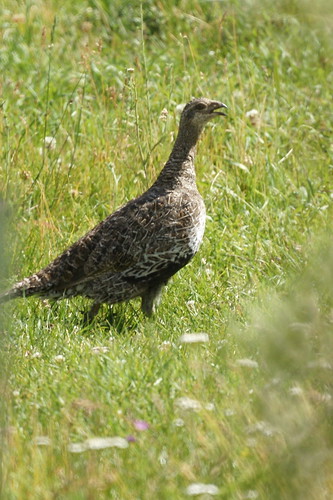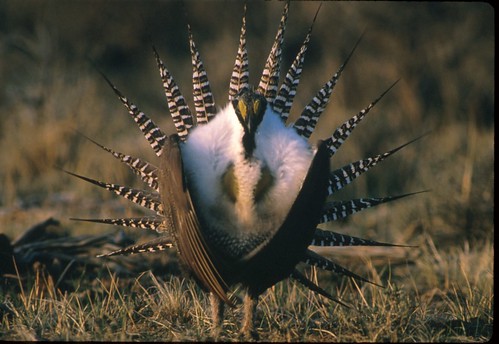美國聯邦政府為阻止小艾草松雞(Gunnison sage-grouse,Centrocercus minimus)這種西部指標性物種長期下降趨勢,漁業暨野生動物局提案將其列入「瀕危物種法」的瀕臨絕種物種,並劃定170萬畝的重要棲地。
保育團體2000年第一次請願保護此物種。環保團體「野性地球守護者」(WildEarth Guardians)野生動物方案主任Mark Salvo表示,「小艾草松雞終於得到牠應有的保護。名列瀕危物種法將對保育該物種提供有效支持。」
小艾草松雞是美國處境最艱困的鳥種。美國奧杜邦協會認為小艾草松雞是美國前10大頻危鳥類之一,同時瀕危物種聯盟(Endangered Species Coalition)也表示小艾草松雞是美國處境最艱困的鳥種。
內政部長沙拉薩(Ken Salazar)的《2009年鳥類現況》報告中提及,棲息著小艾草松雞和其他敏感野生動物的美國西部沙漠和草地,是全國退化最嚴重的棲地。
小艾草松雞面臨的主要困境就是由於住宅、城市及商業發展,及道路和電線等相關基礎建設導致的棲地喪失、退化及破碎化。一些估計顯示過往小艾草松雞的棲地90%已喪失。
美國鳥類保育協會的Steve Holmer表示,「將牠加入瀕危物種名單對這種神奇的鳥類是個轉捩點;隨著不斷發展和持續增長人口的壓力,剩餘棲息地迫切需要穩健保護措施。」
2010年9月15日,漁業暨野生動物局決定將小艾草松雞加入瀕危或受威脅名單但被更高優先的行動方案排擠。
該局將小艾草松雞排入候補名單中並給予高優先順位,認為松雞面臨的威脅是高度且直接的。隨後他們和「野性地球守護者」及生物多樣性中心分別簽署協議,議訂2012年不是小艾草松雞列入瀕危名單就是不採納決議,並需於2013年10月做出決定。
 作為協議的一部份,漁業暨野生動物局同意公布法規計畫書,將小艾草松雞列於名錄中並指定重要棲地。
作為協議的一部份,漁業暨野生動物局同意公布法規計畫書,將小艾草松雞列於名錄中並指定重要棲地。
分類學者早在1970年代便提出小艾草松雞有別於艾草松雞(Greater sage-grouse),2000年正式被美國鳥類學者協會認定為新種。
過去小艾草松雞分佈範圍可能包括科羅拉多州、猶他州、新墨西哥州和亞歷桑那州,現在只有科羅拉多州西南部和猶他州東南部有8個的小族群。小艾草松雞族群量顯著下降,目前約只剩4000隻可繁殖個體。
落磯山野地生物學家Megan Mueller指出,「在西科羅拉多地區小艾草松雞是生活網中很重要的一部份,瀕危物種法保護松雞除了保護該物種本身,也有助於其他包括麋鹿、鹿還有羚羊等野生動物的棲地保育。我們有義務留下一個更好的世界給未來世代,這意味我們必需成為好的土地管理人及保護所有野生動物的棲地。」
Holmer表示,「由於土地使用方式改變及外來植物入侵等因素,小艾草松雞分佈地區的山艾(Sagebrush)棲地越來越破碎化。人類開發諸如道路、電力建設、住宅建設及其他因素導致棲地破碎化導致小艾草松雞及艾草松雞的衰亡。」「從1980年起,小艾草松雞活動範圍內的人口平均成長了70%;甘尼遜河盆地是現存小艾草松雞的主要活動範圍,預估該區人口到了2050年會比2005年增長2.3倍。」
科羅拉多州甘尼遜郡(Gunnison County)約有現存總數80%的小艾草松雞,2050年人口預測將倍增至31100人。
美國鳥類保育協會表示,隨著人口成長而增長的電線設施,將會使得金鷹數量也隨之成長。金鷹是松雞的主要天敵,會使用電線作為覓食狩獵的棲點。
根據一份在猶他州東北部的研究成果,離松雞共有繁殖展示場域(leks)220碼內的電線架設好後,金鷹在該場域松雞補食率由26%上升到73%,最後導致該場域被松雞放棄。
家畜會直接和松雞競爭牧場資源。放牧會減少松雞的繁殖及育雛棲地,對松雞族群量造成負面影響。
聯邦土地目前有松雞使用的棲地至少有87%被放牧者使用。家畜可能會踐踏松雞的巢及築巢環境。雖然這樣的踐踏對族群量的影響程度目前尚無數據,對巢的破壞已被證實,且放牧家畜會導致松雞棄巢。
生物多樣性中心的瀕危物種主任Noah Greenwald表示:「小艾草松雞終於得到牠們亟需的保護,這種獨特而美麗的鳥類需要一個免於城市擴張及其他威脅的安全天堂。」
The U.S. Fish and Wildlife Service has proposed to list the Gunnison sage-grouse as Endangered under the Endangered Species Act and designate 1.7 million acres of critical habitat in an effort to halt the long term population decline of the iconic western bird.
Conservation organizations first petitioned to protect the species in 2000.
“The Gunnison sage grouse might finally get the protection it deserves,” said Mark Salvo, wildlife program director for WildEarth Guardians. “Federal listing will buttress efforts to conserve the species.”
Gunnison sage-grouse are among the most imperiled species in the United States. The National Audubon Society has identified the bird as one of the 10 most endangered in the country, and the Endangered Species Coalition declared Gunnison sage-grouse as one of the nation’s most imperiled species.
Interior Secretary Ken Salazar’s status report, “The State of the Birds 2009,” found that western deserts and grasslands – inhabited by the Gunnison sage-grouse and other sensitive wildlife – are among the most degraded habitats in the country.
The main threats to Gunnison sage-grouse are habitat loss, degradation, and fragmentation due to residential, urban, and commercial development and associated infrastructure such as roads and power lines. Some estimates suggest that over 90 percent of the bird’s historic habitat has been lost.
“Adding the Gunnison sage-grouse to the list of endangered species marks an important turning point for this amazing bird,” said Steve Holmer with the American Bird Conservancy. “With ongoing development pressure and a growing human population, firm protection measures for its remaining habitat are urgently needed.”
On September 15, 2010, the Fish and Wildlife Service determined that listing the Gunnison sage-grouse as an endangered or threatened species was warranted but precluded by higher priority actions.
The agency added the sage grouse to the candidate species list and assigned a high listing priority, saying that threats to the species were of high magnitude and immediacy. It also classified the Gunnison sage-grouse, Centrocercus minimus, as a full species.
The Service then struck separate settlement agreements with WildEarth Guardians and the Center for Biological Diversity that scheduled either a proposed listing decision or “not warranted” determination for 2012 and a final decision by October 2013.
As part of this agreement, the Service agreed to publish a proposed rule to list Gunnison sage-grouse and designate critical habitat. This proposal satisfies that requirement.
The Gunnison sage-grouse is distinct from the Greater sage-grouse, identified by researchers as early as the 1970s and recognized as a new species by the American Ornithologists’ Union in 2000.
While its historic range may have included parts of Colorado, Utah, New Mexico and Arizona, the species now occurs only in eight small populations in southwestern Colorado and southeastern Utah. Gunnison sage-grouse have experienced significant declines from historic numbers, and only about 4,000 breeding individuals remain.
“The Gunnison sage-grouse is an important part of the web of the life in western Colorado,” said Megan Mueller, biologist with Rocky Mountain Wild. “Endangered Species Act protection for sage grouse will help protect not only this fascinating bird, but also habitat for other wildlife, including elk, deer and antelope. We have a responsibility to leave the world a better place for future generations, and that means being good stewards of the land and protecting habitat for all wildlife.”
“Sagebrush habitats within the range of Gunnison sage-grouse are becoming increasingly fragmented as a result of various changes in land uses and the expansion in the density and distribution of invasive plant species,” said Holmer. “A variety of human developments including roads, energy development, residential development, and other factors that cause habitat fragmentation have contributed to or been associated with Gunnison and Greater sage-grouse extirpation.”
The human population in all counties within the range of Gunnison sage-grouse averaged a 70 percent increase since 1980. The projected human population for the year 2050 for the Gunnison River basin, the majority of the current range of Gunnison sage-grouse, is expected to be 2.3 times greater than the 2005 population.
The population of Gunnison County, an area that supports more than 80 percent of all Gunnison sage-grouse, is predicted to more than double to approximately 31,100 residents by 2050.
These population increases typically bring increases in power line installation which can cause a significant increase in grouse predation from golden eagles that use the power lines as perches to attack from, says the American Bird Conservancy.
In one study, golden eagle predation on sage-grouse on communal breeding areas known as leks increased from 26 to 73 percent of the total predation after completion of a transmission line within 220 yards of an active sage-grouse lek in northeastern Utah. The lek was eventually abandoned.
Livestock may compete directly with sage-grouse for rangeland resources. Grazing by livestock could reduce the suitability of breeding and brood-rearing habitat, negatively affecting sage-grouse populations.
At least 87 percent of occupied Gunnison sage-grouse habitat on federal lands is currently grazed by domestic livestock. Livestock can trample sage-grouse nests and nesting habitat. Although the effect of trampling at a population level is unknown, outright nest destruction has been documented, and the presence of livestock can cause sage-grouse to abandon their nests.
“Gunnison sage-grouse are finally getting the protection they desperately need to survive,” said Noah Greenwald, endangered species director at the Center for Biological Diversity. “This unique and beautiful bird needs a safe haven from urban sprawl and other threats.”
※ 全文及圖片詳見:ENS







